Yesterday, I braved the crowds at Asakusa’s Senso-ji temple to witness a time honored Japanese tradition – shaking babies. No, I don’t mean the sort of behavior that results in Shaken Baby Syndrome, but the infinitely more entertaining one type that involves young sumo wrestlers.
Every year on the 4th Sunday of April, Senso-ji Temple at Asakusa holds a nakizumo festival, where young sumo wrestlers stand in a traditional sumo ring and compete to see who can make a baby cry the loudest and longest. A referee watches and yells, “Nake nake nake! (Cry, cry, cry!)” until finally declaring one baby the winner. The cries of the babies are supposed to bring good fortune to the children and drive away evil spirits. This type of festival is held in a various locations around Japan…in Asakusa, it has been going on for 400 years.
I was a little disappointed that they didn’t recruit full-grown sumo wrestlers to scare the kids into crying, I would have loved to see a big sumo wrestler holding a tiny baby. Instead, we got two sumo-wrestlers-in-training. Neither one of them looked much older than 15 to me. It was quite entertaining to watch these two chibi-sumos try to make the babies cry – one was fond of throwing the kids into the air (which they seemed to enjoy more times than not) while the other was trying to be very nice to the babies (which only seemed to make then cry harder). That’s babies for you, fickle creatures indeed.
When neither of the sumos could make a baby cry, the judges busted out some silly plastic oni (demon) masks and wore them in front of the babies – which made the audience burst out into laughter and the kids burst out into tears. Can anyone say, ‘Traumatized for life’?
Every person why applies to the JET Program knows that they are going to be assisting in teaching English in some way during their time in Japan. The title ALT can mean anything from BigDaikon‘s infamous ‘glorified tape recorder’ to being given the responsibility of designing and teaching all of your classes (which is my situation…lots of work and a steep learning curve, let me tell you!). But something that I definitely DID NOT expect to find myself doing was giving JAPANESE LESSONS.
One of my schools has a heavy ‘international’ focus. Part of this involves the school not only sending students to study abroad (in places like Switzerland as well as the US). It also means that every year a new international student is brought to study at the school and live with the Japanese students in the dorm. Last year’s student was an extremely smart Korean girl who not only spoke fantastic Japanese but near-fluent English as well. She came to speak with me every day after school and I really loved listening to her whip out slang from episodes of Gossip Girl. Seriously, I had to start watching the TV series so that I could keep up with her…and to be able to field her many questions about American culture and teenagers. No, not all American teenagers are drug addicts. No, American teenagers do not leave school and head directly to the nearest swanky bar and knock back martinis. On a side note, this is probably the only time in my life that people will tell me that I look like Serena van der Woodsen.
But, I digress.
The new international student is an equally bright boy from Vietnam. Yesterday, my favorite English teacher came to my desk and asked me if I would help teach him Japanese every Wednesday after school. My initial reaction was something to the effect of:
“Are you joking? No one should ever learn Japanese from me!”
Sounds like a case of the blind leading the blind here…or more accurately, a retarded blind person (namely me) leading an unsuspecting victim off a cliff. The reason why this situation came about is because the new exchange student can’t speak any Japanese but CAN speak excellent English. So, the Japanese English teachers have taken him under their wing. Unfortunately, none of the English teachers have any experience teaching Japanese (or taking Japanese lessons, obviously). And thus they turn to me – the retarded blind person.
Now, before you go off criticizing the Japanese education system or the JET Program, I want to say that this isn’t really a bad idea. Not only do I have a large amount of Japanese language textbooks lined up of my bookshelf, I have also taken three years of Japanese lessons. More importantly, my role here is more to provide moral support and a break from his mandatory three hours of sitting in the library studying Japanese from a textbook every day. I know exactly how much fun sitting alone in a room with a Japanese textbook for hours can be…NONE. On top of this, these lessons take place after school on a purely volunteer basis. Today was our first Japanese class and I made it clear that, while I would be helping Sensei teach him Japanese, I would also take the role of a student in this class. I will be doing all of the homework and tests alongside him.
I have to say, I have enormous respect for this kid and his determination. He can’t speak any Japanese. At all. Other than two months of studying from a textbook, he hasn’t taken any Japanese classes. He can read hiragana, some katakana, and no kanji. And yet he was brave enough to come to Japan and study abroad in a Japanese school for a year. When I was his age, just going to my private Japanese tutor’s house every Sunday was enough to make me a nervous wreck. AND, when it comes to our Wednesday classes, he is not only trying to learn Japanese from scratch but he is also having it explained to him in English, another foreign language! Writing this fills my head with terrifying images of me being taught Japanese in German. Terrifying, I say, absolutely terrifying!
We’re starting from Chapter 1 and 2 of the first volume of Genki, the textbook series that I used during my first two years of Japanese classes in university. This chapter covers the most elementary basics of Japanese grammar, like:
__X__ は__Y__ です。 As in: 私はコンスタンティンです。
What really surprised me is that, halfway through an explanation about conjugating Japanese verbs, I realized that I’m not as inept as I thought I was when it comes to Japanese. Don’t get me wrong, I’m definitely inept – just not completely inept. I tend to think that I can’t speak Japanese until I open my mouth and Japanese pops out. Looks like this is another lesson in “Constantine needing to relax, stop worrying, and just do it.” That’s my life, a perpetual Nike advertisement.
I believe that the most difficult truth we must accept in our lives is that everything – the world, people, ourselves – changes. It seems redundant to state such a fact because of its obvious truth. Of course everything changes. Yet, like most important truths, the inevitability of change is both very easy to acknowledge in an abstract, intellectual fashion and exceedingly difficult to come to terms with in practice. Some changes are exciting and welcome; others are painful and unexpected. But one thing is certain – they will come. Be it with earth-shattering swiftness or at a slow creep that goes unnoticed until one day you wake up and find yourself irreversibly altered. They will come. And I have become convinced that it is our ability to confront and adapt to change that defines who we are as people.
The premise of Daybreakers is simple – vampires are real and have become the dominant species on the planet. But it’s not all sappy teen romance and glitter in the sunlight (thank god). As a result of the over-expansion of their population, vampires now suffer from a Malthusian curse. In other words, they’re about to drain the dwindling human population dry. Unlike humans, however, vampires don’t just quietly starve to death. Prolonged blood deprivation turns them into Nosferatu-like homicidal maniacs. Ethan Hawke plays Dr. Edward Dalton, a hematologist who is trying to develop an acceptable blood substitute, ideally one that doesn’t induce projectile vomiting and bloody, spontaneous combustion. Meanwhile, vampire society is undergoing an all-too-human transformation towards fascism (and clearly fascist society demands its citizens to dress in a melodramatic film noir style reminiscent of The Maltese Falcon circa Blade Runner). The new corporate-fascist society is run by none other than Sam Neill.
By far the most impressive climbing photos I have are from my ascent of Montezuma’s Tower in the Garden of the Gods, a 140 ft. spire just past South Gateway rock. Ironically enough, this is one of the easiest climbs I have ever done. Guidebooks rate this climb as a 5.7 but I’d say it’s actually about a 5.5. It just goes to show that those gnarley photos you see in climbing magazines aren’t always the hardest climbs.
In the case of Montezuma’s Tower, the foot holds look like they were cut into the rock. The inflated rating is probably due to the Tower’s height and exposure – it’s not a climb that inexperienced people should just hop onto. There are 8 bolts. About 100 ft up there is a nice belay ledge (pictures to the left). You need two ropes to rappel down from a three bolt anchor on top.
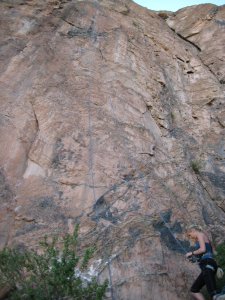 Kindergarten Rock (located south of the main park area) offers a different kind of rock than that found on North and South Gateway Rocks. It’s more like limestone – hard, sharper, more broken and less gritty. Overall, Kindergarten Rock is my favorite place to climb in the Garden. However, most of the easier climbs are trad – only the route rated over 5.10 seem to have blots – so you’ll need to bring some gear. There are some awesome multi-pitch climbs on this rock and the face is pretty steep so there are some wicked airy views from the anchors. Kindergarten Rock has some great cracks (some are really big) but they are pretty dirty and some smell bad because of the birds that live in them.
Kindergarten Rock (located south of the main park area) offers a different kind of rock than that found on North and South Gateway Rocks. It’s more like limestone – hard, sharper, more broken and less gritty. Overall, Kindergarten Rock is my favorite place to climb in the Garden. However, most of the easier climbs are trad – only the route rated over 5.10 seem to have blots – so you’ll need to bring some gear. There are some awesome multi-pitch climbs on this rock and the face is pretty steep so there are some wicked airy views from the anchors. Kindergarten Rock has some great cracks (some are really big) but they are pretty dirty and some smell bad because of the birds that live in them.
A fun, crimpy sport route that leads up the east face of Kindergarten Rock. It’s pretty sustained climbing and some slippery moves near the end definitely require good balance. This is a great forearm workout.
New Era, 5.7
A classic trad route that runs up the crack/dihedral on the east face of Kindergarten Rock. Bring medium to large pro because it’s pretty big. When I climbed this route with Arek, we reached the summit with three pitches. There are decent anchors, though the first one is tight…the first pitch is the easiest and a good place to set up a top rope for beginners – as a did when Sebastian visited.
The Manitou Incline runs up the side on Mt. Manitou along old railroad ties – basically 1.1 miles of wooden steps up a mountain. It has an 89% average grade and a 2,000 ft elevation gain. It’s also exposed to the sun, making for a brutal workout.
Barr Trail starts near the Cog Railroad and continues up to the summit of Pikes Peak. It’s about 13 miles long and an easy trail leading up to a popular 14er. Barr Camp is located off the trail just below treeline. You can camp here in lean-tos or tents – and be sure and stop in the cabin to chat with the caretakers and eat some yummy pancakes!
Adam’s Mountain Café – the best restaurant in Manitou! It serves ‘slow food’ that is organic, local and definitely worth the wait. I recommend breakfast the most, it’s a great place to eat after running Ute Indian Trail or going up the Incline.
 My first outdoor climb of Summer 2008 was in the Garden of the Gods. The Garden of the Gods is a great sport/trad climbing area located in the middle of Colorado Springs, about 10 minutes west of I-25 off the Garden of the Gods exit. Free to the public, the Garden is a good place for some qucik climbing on good, gritty red sandstone. Just sign the ‘idiot waiver’ at the Visitor’s Center and carry your rope and qucikdraws down the sidewalk and climb away. Be prepared for an audience though. Needless to say, I was a bit rusty from well over a semester of inactivity, no rock climbing and still coming out of the depression that had nearly shut down my life at the end of 2007. Following my newfound policy of making rather irrational, yet carefully planned out, decisions, I climbed in the Garden with a boy I had met on the internet and had never climbed with before. Of course, climbing well-bolted 5.6s and 5.7s in the Garden is an extremely well-calculated risk…and Scott’s experience and ability far outweighed any dangers. Little did I know at the time, but meeting Scott would completely change the course of my summer and launch me into three months of travel and climbing, solidifying my love for the outdoors and Colorado.
My first outdoor climb of Summer 2008 was in the Garden of the Gods. The Garden of the Gods is a great sport/trad climbing area located in the middle of Colorado Springs, about 10 minutes west of I-25 off the Garden of the Gods exit. Free to the public, the Garden is a good place for some qucik climbing on good, gritty red sandstone. Just sign the ‘idiot waiver’ at the Visitor’s Center and carry your rope and qucikdraws down the sidewalk and climb away. Be prepared for an audience though. Needless to say, I was a bit rusty from well over a semester of inactivity, no rock climbing and still coming out of the depression that had nearly shut down my life at the end of 2007. Following my newfound policy of making rather irrational, yet carefully planned out, decisions, I climbed in the Garden with a boy I had met on the internet and had never climbed with before. Of course, climbing well-bolted 5.6s and 5.7s in the Garden is an extremely well-calculated risk…and Scott’s experience and ability far outweighed any dangers. Little did I know at the time, but meeting Scott would completely change the course of my summer and launch me into three months of travel and climbing, solidifying my love for the outdoors and Colorado.
The following day, I took advantage of another invite to the Garden, this time to climb with several soldiers who had recently returned from deployments in Iraq. This turned out to an extremely different experience, with some much more aggressive repelling and some rather large falling rocks. Three routes stick out in my memory:
Located on the west side of South Gateway rock, West Point Crack is a sandbag 5.8 route leading up to a well placed anchor. The route continues onto a second pitch, but the quality of the rock rapidly deteriorates and ultimately isn’t worth it. West Point Crack isn’t really a ‘crack’ so much as a very very big flake. Liebacks can be used but the crack is so big you can just step up it like stairs. It’s well-bolted and safe – with the exception of the first move. The route starts above the belay station on an exposed ledge – the move calls you to lean back then step up onto the ledge. It’s a bit boulder but once you get yourself on the rock the route becomes really easy. Like I said before – sandbag.
Credibility Gap 5.9
A much more exposed route that West Point, Credibility Gap starts behind the large flat rock that juts up in front of South Gateway rock. It also follows a crack/flake up to the anchor and is protected with pins and fixed pitons. The area right under the anchor get pretty bare and people seem to frequently pull off flakes of rock right there, so be prepared to do some dodging if you have a grabby climber on belay. Definitely a fun route!
Located on the Drug Wall of South Gateway Rock (the side that faces east), Mighty Thor is an awesome sport route that stems up a dihedral to an anchor. There are some big reaches, some serious liebacks, and stemming. This is a fun, pumpy route that requires a lot of balance and patience as the tourists walk by commenting on your progress. This is one of my favorite routes in the Garden, so I definitely recommend it.



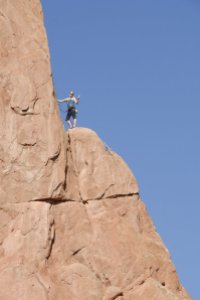
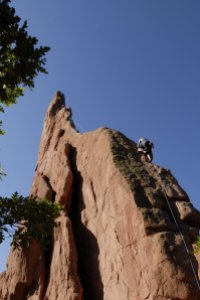


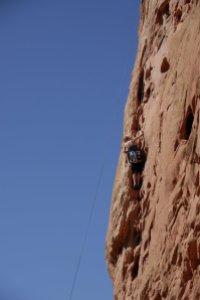
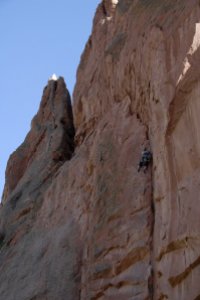
Recent Comments